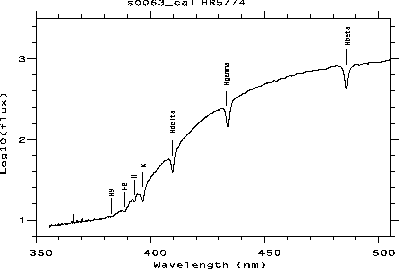We have implemented this mode in PISCO since some authors had already shown the feasibility of speckle spectroscopy (Weigelt et al., 1991, Kuwamura et al., 1992).
The speckle camera can be easily converted to a spectrograph since a grism is available at the filter wheel FA and a slit can be put into the entrance image plane (I1) (i.e., wheel EN, cf. Fig. 1).
This low dispersion spectrographic mode
provides a spectral range of 350-500 nm range,
with a resolution of ![]() 300 with a
slit of 0.7 ".
This range was chosen to allow for stellar classification
of close binaries with the hydrogen Balmer series, although it is more
difficult to obtain good images in blue because of a stronger atmospheric
turbulence.
300 with a
slit of 0.7 ".
This range was chosen to allow for stellar classification
of close binaries with the hydrogen Balmer series, although it is more
difficult to obtain good images in blue because of a stronger atmospheric
turbulence.
This mode can be remotely selected by rotating the wheels of PISCO and thus allow quick switching between imaging and spectroscopy. This allows to easily center the object on the slit. High angular resolution can be obtained along the entrance slit direction by applying one-dimensional speckle imaging techniques to each monochromatic image of the slit (see §5.2).
The first spectroscopic observations have been made in 1995. Unfortunately the poor seeing conditions and the low dynamic range of the detector did not allow us to restore high resolution images. We simply obtained conventional spectra and calibrated the whole instrument with known stars.
The wavelength calibration can be performed with calibration spectral lamps in wheel AS (Halogen, Argon, Neon and Xenon lamps).

Figure 10: First spectrum obtained with PISCO (HD 5774)